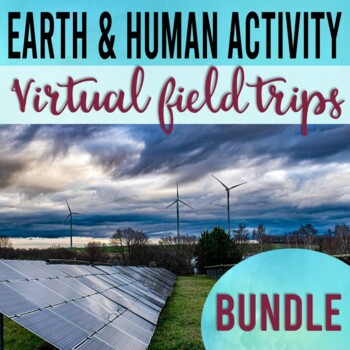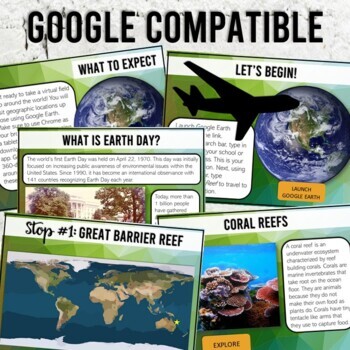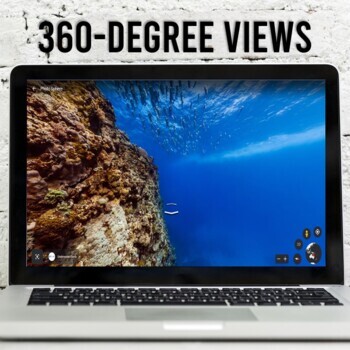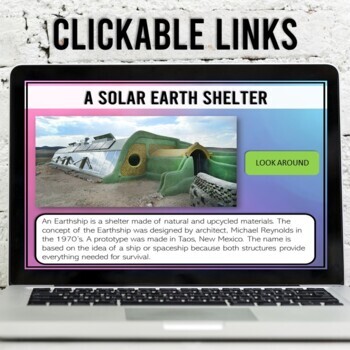Earth & Human Activity Virtual Field Trip Bundle (Google Earth Exploration)
- Zip
- Google Apps™
- Internet Activities

What educators are saying
Products in this Bundle (2)
Description
This virtual field trip bundle is a great way to infuse technology, spark curiosity, and bring to light the complexities of the changes in the Earth, as well as various solutions to address sustainability. Using a combination of Google Earth™ 360-degree views, informational text, video, and visuals, your students will learn about and explore Earth and human activities from various perspectives.
This Bundle Covers:
1. Earth Day VFT
:: What is Earth Day?
:: Great Barrier Reef (coral bleaching)
:: Great Pacific Garbage Patch (ocean plastic pollution)
:: Amazon Rainforest (deforestation)
:: Dehli, India (air pollution)
:: Mozambique, Africa (freshwater access)
:: The Arctic (shrinking sea ice, drilling)
2. Sustainable Communities VFT
:: What are sustainable communities?
:: Earthships, New Mexico (self-sufficient living & upcycled materials)
:: Biosphere 2, Arizona (largest closed earth system)
:: Zero Waste Town, Japan (impact of recycling & community policy)
:: Solar Power Complex, Morocco (clean energy & reduction of imports)
:: Ecovillage, Scotland (eco-friendly living & misconceptions)
Virtual Field Trips Include:
:: Informational Text (build background knowledge)
:: Response Questions (EDITABLE)
:: Google Earth™ Links to 360-degree views
:: Video Links
:: Grading Rubric
:: Everything is set up in Google Slides & ready to go!
SEE PREVIEW FOR MORE DETAILS
How it Works:
These virtual field trips can be conducted teacher-led or shared with students through Google Classroom as an independent assignment. Everything is set up for you. These resources are LOW PREP and would even make great sub plans. Student directions are found within the lessons, and direct links are included to specific Google Earth™ locations and videos. All work is completed digitally. No printing necessary.
Structure:
These virtual field trips are structured. This means that the informational text and links are meaningful and are meant to lead students to think critically as they respond to the questions throughout the virtual field trip. This is also a great way to keep students accountable as they learn and explore. All response questions are EDITABLE, so you can tailor to your class needs. Students complete this activity in edit mode of Google Slides.
Standards Alignment:
:: Next Generation Science Standards Human Sustainability; Earth & Human Activity
:: Common Core Standards for Reading Informational Text
:: Washington Geography Standards
:: Can be used as a cross-curricular activity as it fits many different standards
Grading Rubric:
A grading rubric is included which assesses: accuracy, thoroughness, validity, and writing conventions. Answers will vary throughout, as students are recording their observations and findings.
Technology:
Please note that students will need to access Google Earth™ to complete these assignments. Google Earth™ can be accessed on a desktop using Chrome as the browser. If using a tablet or smartphone, simply download the Google Earth App before starting the virtual field trips. Your students will also need access to YouTube to view the video clips.
If you have questions, feel free to reach out prior to purchasing. Looking for another virtual field trip that you don’t see? Let me know! I can be reached directly by email at: michellemcdonald9515@gmail.com
Thank you!
Michelle McDonald, B.A.E.
Social Studies Education, K-12
Elementary Education K-8
* * * * * * * * * * * * * * * * * * * * * * * * * * * * * * * * * * * * * * * * * * * * * * * * * * * * * *
Connect with Me:
Instagram @mrsmcdonaldsclassroom
Facebook: mrsmcdonaldsclassroom
Blog: StrategicEducationalServices.com
* * * * * * * * * * * * * * * * * * * * * * * * * * * * * * * * * * * * * * * * * * * * * * * * * * * * * *
Follow me on TpT to be the first to learn about new products, sales, and discounts. Follow Michelle McDonald





